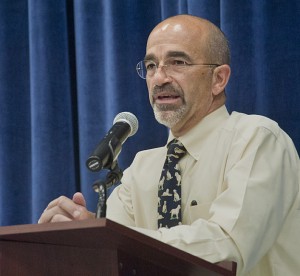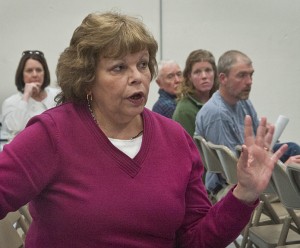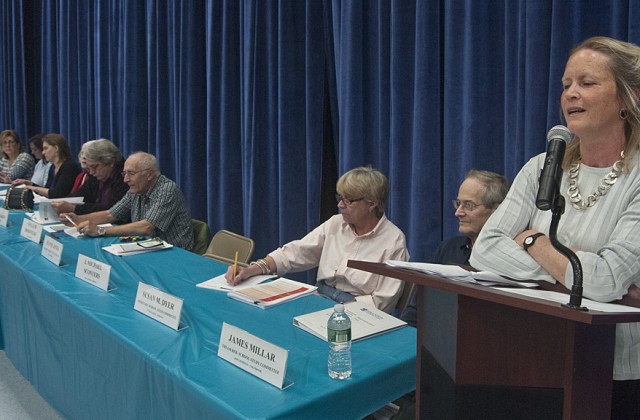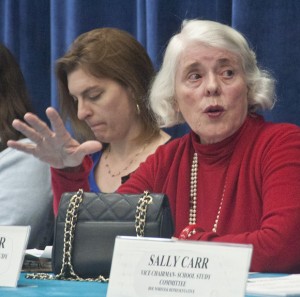Regionalization Committee Issues Draft Proposal
Consolidation not expected before 2016-2017 at earliest
By Wiley Wood

Jonathan Costa, an education consultant hired by Norfolk and Colebrook: “Think of regionalization as a great ship.”
No regional school district has been created in Connecticut since the 1970s, but the Norfolk-Colebrook Regionalization Study Committee, formed in the wake of town referendums in 2012, has made a stab at it. The group presented its proposal on May 20 to an occasionally rowdy group in Norfolk and again on May 22 in Colebrook. Some aspects, said Jonathan Costa, an educational consultant hired to facilitate the process, still need to be vetted before moving on to the next step.
The first hurdle to bringing the two districts under one newly formed regional authority is the educational program itself. “In the old days,” said Costa, “the study would just provide a half page about the educational program.” This committee spent several months devising a detailed model in which all the current offerings of each school were dovetailed into one joint program.
“The question is,” said Costa, “are we tying the hands of the regional board forever by making too specific a set of recommendations?” The committee’s proposal will go first to State Board of Education for approval and then to the voters of both towns for a referendum vote. If it passes these tests, it will become a blueprint for the new regional board.
The regional board will have four members from each town; their votes will be weighted according to town population, with a mechanism to keep the smaller town from being bulldozed should votes split along town lines.
“If you think of the regional district as a great ship,” said Costa, “once it is launched, once you approve it, the captain and the crew will make the decisions about sailing schedule and cruising speed. They’ll decide what will be served at meals.” The committee is seeking advice from an education lawyer on how detailed a blueprint to submit.
The second hurdle to bringing the two schools together in one building with one principal, one superintendent and one support staff is the Minimum Budget Requirement, a state statute that prohibits school districts from reducing their education spending. A district must, with only minor adjustments, spend as much in any given year as it spent the year before.
A major premise of the committee’s regional model, however, is that costs will drop over time. When the two schools are first brought together, the seven K–6 classes from Colebrook and the seven K–6 classes from Norfolk will each have their own teacher. But as the student population drops—and it’s expected to do so in the decade ahead—some grade levels may be brought together into a single class and some of the teachers may be let go. Costa pointed out that 85 percent of a school’s costs are typically tied up in salaries.
When asked if the regional plan would run afoul of the Minimum Budget Requirement, First Selectman Sue Dyer said that a waiver can be obtained from the state on a yearly basis, as long as a district can prove that its savings are legitimate and not from an impoverishment to its program. But Dyer was quick to say that she would want clarification from the State Board of Education on this point.
A third and final hurdle was flagged when members of the State Board took their first look at the proposal. The per-student costs of a regional school are to be shared, according to state statute, on a basis proportional to each town’s share of the student body. If the two towns each have 50 percent of the students, they each pay 50 percent of the per-student costs. In the committee’s proposal, the cost curve is bent in Colebrook’s favor for the first ten years so that both towns can enjoy savings from the regionalization—$2.6 million each during that period. After the first 10 years, the per-student costs are shared equally. “We get there,” said James Millar, chairman of the Colebrook Board of Finance and architect of the financial plan, “but it takes us ten years.”

Michele Sloane: “There is a reason school budgets have been kept flat. We are going through hard times.”
The state may consider that the Norfolk-Colebrook plan honors the spirit of the statute sufficiently to grant a temporary waiver, according to Sue Dyer. The issue will be explored at the committee’s next regular meeting on May 29, which Representative Roberta Willis and State Senator Kevin Witkos are expected to attend.
An issue that might have been a hurdle, the proposed use of the present Botelle building for the new regional school, raised no eyebrows at the state level, although it raised a chorus of protest at the Norfolk meeting. The town of Norfolk would retain ownership of the structure and lease it to the region for a nominal fee. All the costs of maintaining the building—including capital improvements—would be shared equally by Norfolk and Colebrook.
A dissenting member of the committee, Sally Carr, chairman of the Norfolk Board of Education, reopened the possibility of bypassing regionalization altogether: “I think the two boards [of education] should be talking together. They could put together a contract with tuition or whatever it might be, and we could start this very soon.” In general outline, Carr’s plan would have Norfolk educate all of Colebrook’s students in return for a per-student fee. This approach, which could be implemented without town referendums, has been widely rejected by Colebrook officials. Jeanne Jones, chairman of the Colebrook Board of Education, noted in an interview that the two boards have already explored this avenue and reached a dead end. “But the real reason,” Jones said, “is that this should be decided by the towns’ voters, not the boards of education.”
Comments from the audience ranged from support to vehement opposition. “I don’t really see how it’s going to make my child’s education better,” said Kim Crone, a Botelle parent. Suzanne Funchion of Norfolk said that small class sizes could be a liability and that regional systems have worked well.
The timeline, according to Costa, has been pushed back at least a year due to the legal and legislative uncertainties, with a possible start date in 2016-2017. If regionalization is a great ship that a yes vote in both towns will launch, it is one that is still undergoing tank trials.
Photos by Bruce Frisch.




